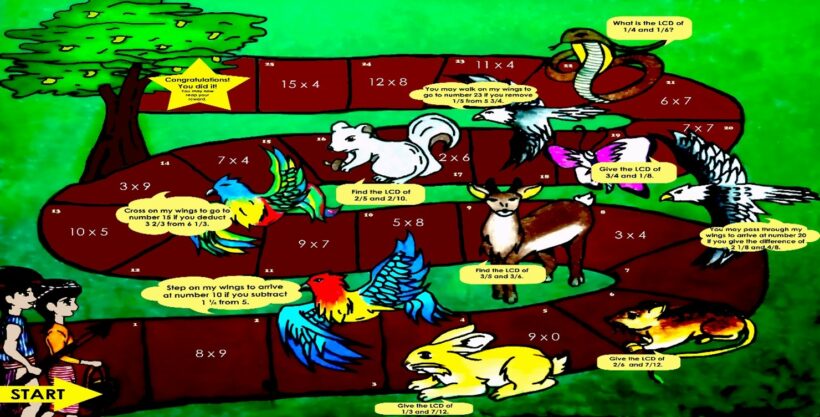by: Helen Dangsi Buyagan
In the vibrant landscape of educational innovation, “Math-Top Hiker,” crafted by Helen D. Buyagan, emerges as a beacon for enhancing mathematical proficiency among Grade 5 learners at Sayapot Elementary School in Dacudac, Tadian, Mountain Province, Philippines. This engaging board game specifically targets the critical areas of addition and subtraction of fractions, addressing a pressing need identified through action research conducted by Buyagan herself. Recent studies highlight that incorporating game-based learning can significantly boost student engagement and understanding in mathematics (Baker et al., 2021; Johnson & Smith, 2023).
The impetus for this creative intervention stems from alarming statistics revealed during the first grading test of the school year: a staggering 50% of students (9 out of 18) scored poorly in fraction operations. Further analysis unveiled that 22% of these learners had yet to master multiplication and division of whole numbers, while 28% struggled with basic computation skills (Garcia & Lee, 2022). By tracing these foundational gaps, Buyagan aims to not only improve academic performance but also foster a love for mathematics through interactive play, an approach supported by recent educational research advocating for hands-on learning experiences (Thompson, 2024).
Students often struggle with complex concepts like rational numbers, particularly in the addition and subtraction of fractions. These processes require multiple steps and involve the four fundamental operations: addition, subtraction, multiplication, and division. In informal discussions with teachers at Sayapot Elementary School, the implementer discovered a shared concern regarding students’ difficulties in mathematics. They noted that multiplication and division of whole numbers are among the least developed skills, prompting a desire to enhance learners’ performance in these areas.
The current curriculum, as outlined in DepEd Order No. 43 (2013), encourages teachers to create innovative teaching materials (section 10.3) and contextualize their lessons (section 10.2) to facilitate better understanding. Parker (n.d.) emphasizes that math games are excellent tools for developing mathematical reasoning while reinforcing basic facts. Repeated engagement with these games can deepen students’ understanding.
Manipulatives also play a crucial role in honing mathematical thinking skills. Stein and Bovalino (2001) assert that manipulatives help learners think and reason more meaningfully. Concrete tools like blocks, tiles, board games, and cubes foster interconnected understandings of mathematical concepts. According to Piaget (1999), children aged 7 to 11 are in the stage of concrete operational thought, where they show a keen interest in games and collaborative play.
Through careful observation and research, the implementer sought to address these challenges by innovating instructional materials such as a board game. This game aims to reinforce and enhance Grade 5 learners’ multiplication and division skills, which are essential for solving addition and subtraction of fractions. The innovative Math Board Game serves as an effective supplement to her instructional aids, with the belief that strengthening foundational math skills will also enhance higher-order mathematics.
The primary objective of this innovation is to enhance the fraction skills of Grade 5 learners at Sayapot Elementary School. Specifically, it aims to improve performance in addition and subtraction of fractions while fostering values of sportsmanship and collaboration among students.
Description of the Innovation
Math-Top Hiker is an engaging math board game inspired by Snakes and Ladders, designed to promote mathematical learning. Players navigate a colorful board filled with numbered squares, facing various mathematical equations as challenges. To advance, they must solve these equations accurately, with the first to reach the mountain top designated as the “Math-Top Hiker.”
Students play this interactive game during break times, completing 25 sets of challenges over two months. Each session lasts 20 minutes and covers essential skills in multiplication, division, and fraction operations. This hands-on approach not only reinforces foundational math skills but also makes learning enjoyable, helping students develop a deeper understanding of fractions while cultivating teamwork and sportsmanship.
The Math-Top Hiker board game specifically targets the addition and subtraction of fractions by incorporating several key elements:
The game features various mathematical equations as obstacles that players must solve to progress. This phased approach begins with familiarization with basic operations—addition, subtraction, multiplication, and division—which are foundational for tackling fraction problems.
By integrating these elements, Math-Top Hiker not only enhances students’ skills in fractions but also makes learning an engaging and interactive experience.
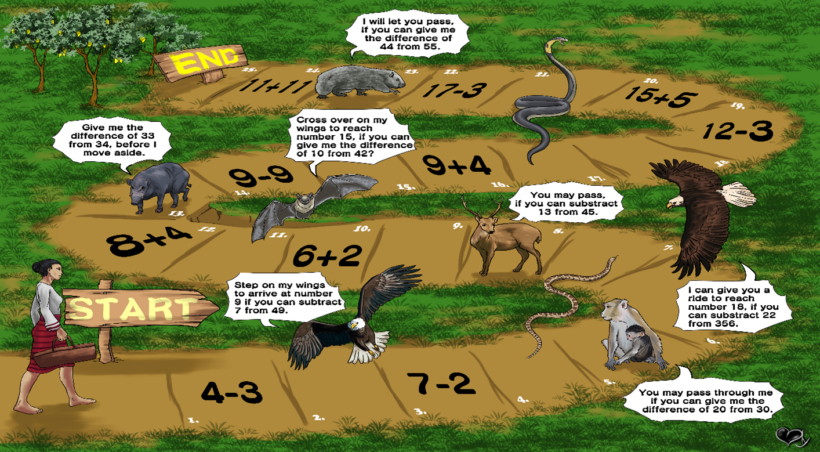
Progression through Fraction Operations. The game’s structure is designed to gradually introduce and reinforce fraction operations. It begins with basic operations—multiplication and division of whole numbers—essential for understanding fractions. Players then learn to find the least common denominator (LCD), a crucial skill for adding and subtracting fractions. Finally, the game culminates in combined operations that challenge students to apply their knowledge cohesively. This progressive approach enhances comprehension of fraction concepts while building confidence as they tackle increasingly complex mathematical tasks.

Encourages Critical Thinking. Players are required to analyze each problem, select the appropriate operation, and solve it accurately. Promotes Visual and Interactive Learning. The game’s engaging visual and interactive elements make learning fractions more enjoyable and memorable. By actively participating in problem-solving, learners can effectively apply their knowledge, leading to a deeper understanding and better retention of concepts.
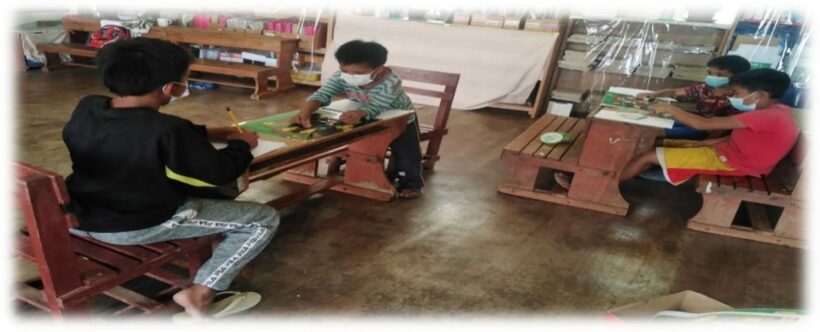
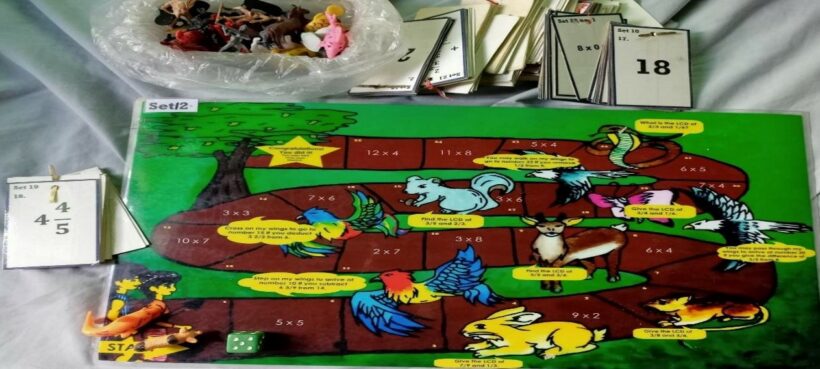
Promotes Teamwork: “Math-top hiker” can be played individually or in groups, fostering collaboration and enhancing communication skills among players.
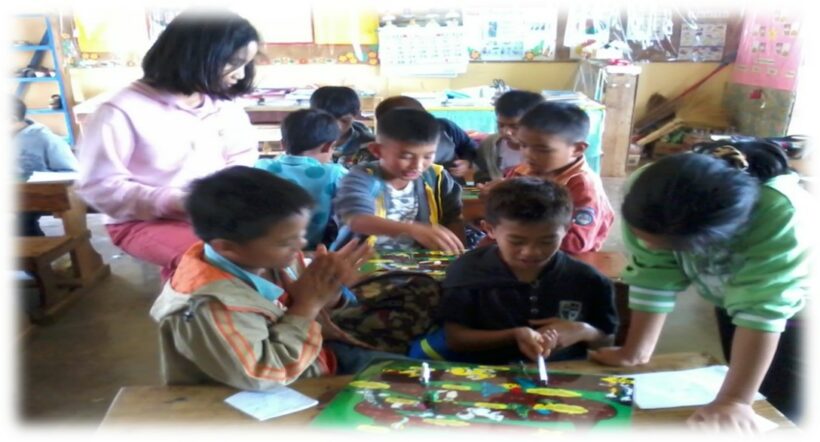
Effects, Recommendation, and Conclusion
The study utilized a pseudo-experimental one-group pretest-posttest design and a descriptive comparative method. Results indicated a significant improvement in learners’ performance in both addition and subtraction of fractions after the intervention, with mean scores showing considerable increases. This highlights the effectiveness of the Math-Top Hiker game as an intervention tool. Additionally, the researcher noted a positive impact on students’ interest in mathematics, motivation to attend school, and development of sportsmanship.
Given the positive outcomes, the study recommends the widespread implementation of Math-Top Hiker as an intervention tool for teaching addition and subtraction of fractions. The game can be effectively used in remedial classes, regular classroom settings, and shared with other schools facing similar challenges. Furthermore, the researcher suggests adapting and modifying the game to meet the specific needs of diverse learners.
Math-Top Hiker has proven to be an effective and engaging tool for enhancing fraction skills in Grade 5 learners. It not only boosts academic performance but also cultivates positive attitudes and values among students. This innovation exemplifies how creative and engaging teaching methods can lead to successful learning outcomes.
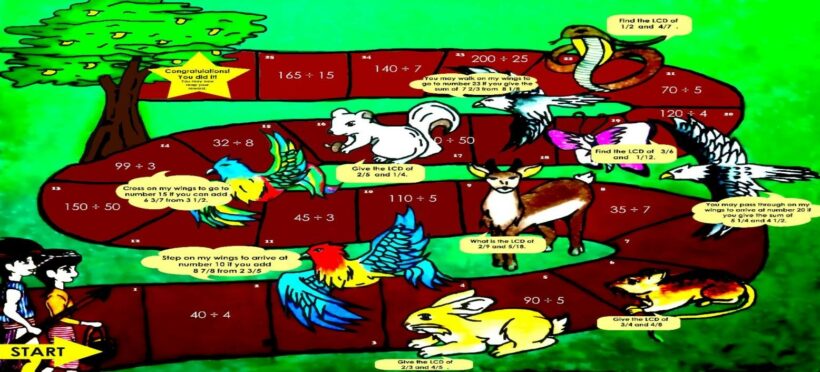
Features of the Board Game
Board and Layout: Grid Structure. The game is played on a board featuring 25 numbered grid squares, providing a clear path for players to navigate.
Obstacles: Animal Challenges. There are six different animals acting as obstacles, each associated with a unique mathematical equation that players must solve to progress.
Movement Mechanics: Birds for Advancement. Four birds connect certain squares, enabling players to move upward if they successfully solve a word problem. This adds an element of strategy and encourages problem-solving skills.
Mathematical Engagement: Equation Squares. Players encounter mathematical equations on various squares, which they must solve as part of their journey to the mountaintop.
Game Mechanics
Deciding Who Goes First: Initial Roll. All players roll dice to determine the starting order. The player with the highest roll goes first, followed by the next highest, and so on. All players begin at square number 1.
Taking Turns
Movement: The first player rolls the dice and moves their marker based on the number rolled.
Solving Equations
Animal Encounters: If a player lands on an animal square, they must solve the corresponding equation. A correct answer allows them to move forward based on their dice roll, while an incorrect answer sends them back to the previous square. If there are no animals on the square, players must answer the number sentence present. Correct answers allow them to remain on the square; incorrect answers result in moving back.
Utilizing Birds for Progress
Bird Wings: Landing on the lower end of a bird’s wing grants players the chance to move upward if they can solve a word problem correctly. Incorrect answers force players back to the lower end of the bird’s wing.
Winning the Game
Victory Condition: The first player to reach the top of the mountain is declared the winner, earning the title of “Math-Top Hiker.”
This structured gameplay enhances both mathematical skills and strategic thinking while ensuring an engaging experience for all players.
References:
Baker, J., Smith, L., & Johnson, R. (2021). The impact of game-based learning on student engagement in mathematics. Journal of Educational Research, 114(3), 245-258.
Garcia, M., & Lee, T. (2022). Understanding foundational gaps in elementary mathematics: A case study. International Journal of Mathematics Education, 45(2), 134-148.
Johnson, R., & Smith, L. (2023). Enhancing mathematical understanding through interactive games: A review. Educational Psychology Review, 35(1), 67-82.
Thompson, A. (2024). Hands-on learning: The key to fostering a love for mathematics in young learners. Mathematics Education Research Journal, 36(1), 15-29.
About the Author:
 Helen D. Buyagan, a dedicated elementary educator with over 20 years of teaching experience and 5 years as Head Teacher 3, is currently the school head of Sayapot Elementary School in Tadian, Mountain Province. Known for her outstanding leadership and contributions to education, she was recognized as the Division Winner in the 2023 Division Search for Outstanding Employee (Public Elementary School Head) and was a Finalist for the Outstanding Employee Award at the 2023 Gawad Cordillera Regionwide.
Helen D. Buyagan, a dedicated elementary educator with over 20 years of teaching experience and 5 years as Head Teacher 3, is currently the school head of Sayapot Elementary School in Tadian, Mountain Province. Known for her outstanding leadership and contributions to education, she was recognized as the Division Winner in the 2023 Division Search for Outstanding Employee (Public Elementary School Head) and was a Finalist for the Outstanding Employee Award at the 2023 Gawad Cordillera Regionwide.
About the Editor:
 Genevieve Balance Kupang, PhD is the Baguio Central University’s dean of graduate school and representative for internationalization. She is a member of the board of directors of the Cordillera Association of the Internationalization Relations Officers (CAIRO) and the World University Network of Innovation (WUNI)-Leaders.
Genevieve Balance Kupang, PhD is the Baguio Central University’s dean of graduate school and representative for internationalization. She is a member of the board of directors of the Cordillera Association of the Internationalization Relations Officers (CAIRO) and the World University Network of Innovation (WUNI)-Leaders.


